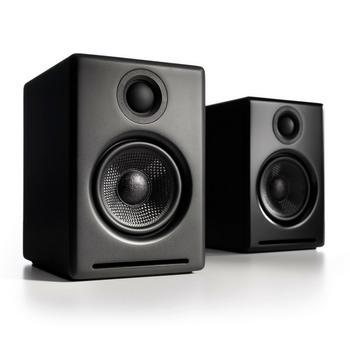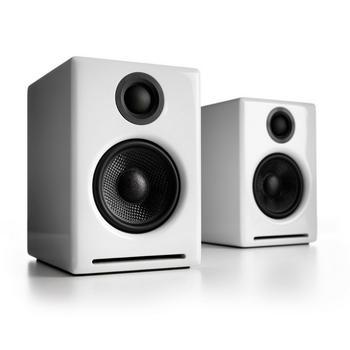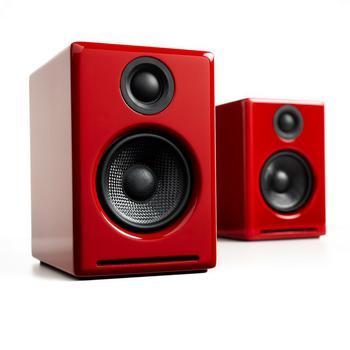- Record Players
- iDevices and all music players
- Internet radio and network music systems
- Desktop computers, laptops, notebooks
- Flat panel TVs with an analog output
- CD and DVD players
- Videogame consoles
- Digital radio and satellite receivers
- All products with 1/8" mini-jack or RCA outputs!



Audioengine A2+ Speakers

[ Overview ]
The Audioengine 2+ is the new standard for audio as these small, but high-performance speakers are the perfect upgrade for your in home record player. Everyone knows the difference between custom-built, small batch products and the disappointment of mass-produced and over-marketed products. The A2+ was designed and hand-built with the goal of exceeding expectations of both value and performance.
The A2+ superb soundstage and imaging makes them the perfect choice for across the room. Well-suited for all your music, movies and games, the A2+ sounds great with or without a subwoofer. Using a similar analog design as the Audioengine 5+, the A2+ power amplifiers are built inside the left speaker providing a very efficient system. An auto-standby idle mode is also included to conserve power when you're not playing music.
- Built-in analog power amplifiers
- Dual analog audio inputs
- USB audio input
- Hand-finished wood cabinets
- Variable audio output
- Custom Kevlar woofers and silk tweeters
- Cables included
- Works with Mac, PC, and Turntables
- A2+ powered (left) speaker
- A2+ passive (right) speaker
- Speaker wire (16AWG), 2 meters (~6.5 feet)
- Power supply
- AC power cord
- Mini-jack audio cable, 1.5 meters (~5 feet)
- USB cable, 1.5 meters (~5 feet)
- Microfiber speaker bags
- Microfiber power supply bag
- Microfiber cable bag
- Setup guide
- Product line brochure
Type
- 2.0 powered (active) multimedia desktop speaker system
Amplifier type
- Dual class AB monolithic
Power output
- 60W peak power total (15W RMS / 30W peak per channel), AES
Drivers
- 2.75" Kevlar woofers, 3/4” silk dome tweeters
Inputs
- 3.5mm stereo mini-jack, RCA, USB
Outputs
- RCA variable line-out
Input voltages
- 110-240V 50/60Hz auto-switching
SNR
- >95dB (typical A-weighted)
THD+N
- <0.05% at all power settings
Crosstalk
- -50dB
Freq. response
- 65Hz-22kHz ±2.0dB
Input impedance
- 10K ohms unbalanced
DAC
- TI/Burr Brown PCM2704C
Input bit depth
- up to 16 bits native
Input sample rate
- up to 48KHz native
USB device class
- type 1.1 or above
Protection
- Output current limiting, thermal over-temperature, power on/off transient protection
Dimensions (each)
- 6”(H) x 4”(W) x 5.25”(D)
Weight (LEFT speaker)
- 1.6Kg/3.55lbs
Weight (RIGHT speaker)
- 1.4Kg/3.15lbs
Shipping weight
- 4.6kg/10lbs per pair
Shipping box dims
- 10.5” (H) x 15” (L) x 7” (W)
Materials and Construction
- 6.35mm thick MDF cabinets
- 3/4" silk dome tweeters with neodymium magnets
- 2.75" Kevlar woofers with advanced voice coils
Included Accessories
- Speaker wire (16AWG), 2 meters (~6.5 feet)
- Power supply
- AC power cord
- Mini-jack audio cable, 1.5 meters (~5 feet)
- USB cable, 1.5 meters (~5 feet)
- Microfiber speaker bags
- Microfiber power supply bag
- Microfiber cable bag
- Setup guide
- Product line brochure
Custom Built
- Audioengine designs and manufactures our own tweeters, woofers, and many other critical components. In other words, these are not "box built" speakers with off-the-shelf parts but entirely custom-designed to our specifications. What we do not fabricate directly in our speaker factory we have custom-made to our designs (parts such as toroidal transformers, magnets, and wiring harnesses, for example). The cabinets, drivers, bass port designs, amplifiers, and crossovers are all painstakingly tuned together for each Audioengine model. This, in turn, makes for a much more efficient system that requires much less power than traditional AV stereo receivers and passive speakers.
Based on Studio Monitor Designs
- Studio monitor speakers are used by producers and engineers in recording and production studios. They are designed with a theoretical flat frequency response which allows the engineer to create a final mix in such a way that the recorded music will sound good on most other speakers. Although Audioengine speakers are not designed to be up-close "nearfield" studio monitors, we do carry over much of the same higher-end technology, components, and design philosophy for Audioengine speakers.
Drivers
- Audioengine uses audiophile quality, ferro fluid cooled, silk dome tweeters with neodymium magnets. Silk tweeters hold up well under high power and the edge-driven design gives very smooth response. The custom woofers are Kevlar woven glass aramid composite with rubber surrounds. Kevlar is obviously very strong, which means that the woofer retains its shape when being driven at high levels. The speaker materials and construction are very robust, therefore speaker grills aren’t needed. In other words, we did our homework on the speaker drivers and they will sound and look great after many years of use.
Cabinets
- To minimize unwanted resonances and distortion, Audioengine cabinets have thick high-resin MDF walls with extensive internal bracing. Heavy internal sound-damping material is used to reduce unwanted sound reflections inside the cabinet. All cabinet edges are rounded which look great and reduce high-frequency diffraction effects on the front baffles. Each cabinet contains tuned, front-port slots. Both speakers are tuned and tested together and sold in pairs.
Power Amplifier
- The amplifiers in Audioengine speakers are located in the left speaker and are a very conservatively rated analog design. Each subsystem is tuned together for all models, which provides a much more efficient system requiring less power than passive speakers and separate amplifiers. Circuit boards for the power and preamp sections are vertically mounted for maximum mechanical shock protection (a good thing).
Shielding
- Both drivers are magnetically shielded and allow the user to place the speakers within a few inches of a video monitor. This shielding also offers protection for hard-drive digital music players.
- Available in the US only

The high quality packaging really showed that Vinylmnky cares about how your record arrives.
Prompt with any questions asked, fast, reliable shipping with a tracking number and high quality records.
It's really a fantastic way for collectors to build their library and discover new music that maybe you wouldn't normally listen to.